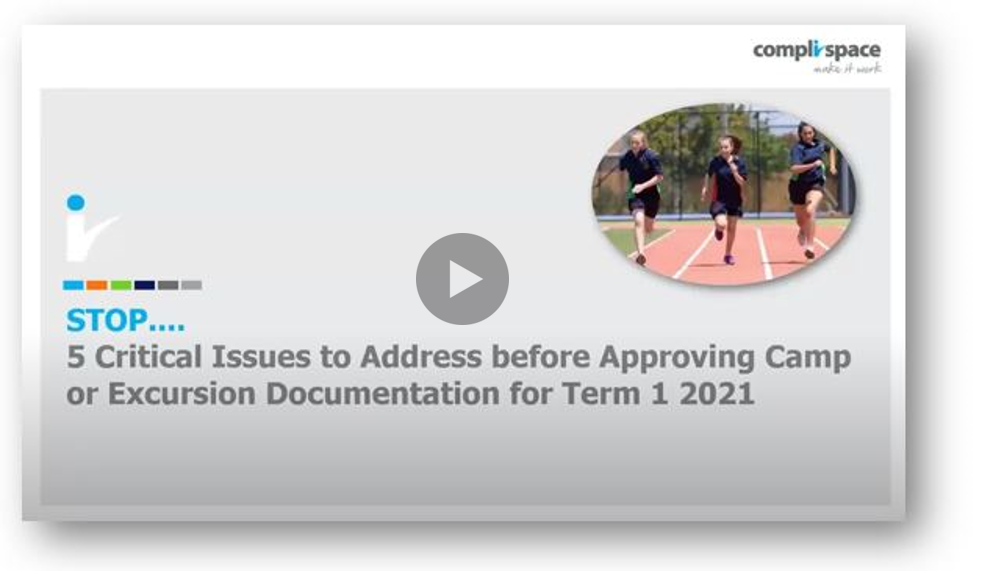Using External Providers for Excursions: What Do Schools Need to Consider When Managing Risk?

Schools frequently use external providers as part of their excursions. These include transport, food and activity providers and external venues. Schools often have a number of questions and concerns in relation to managing risk when they plan an excursion using external providers. We address some of these by way of some questions and answers below.
When using an external provider, is it best practice to request and use the external provider's risk assessment or does the school need to do its own risk assessment?
The School’s Obligations
In terms of managing risk, it is ultimately the responsibility of the school to have done their own risk assessment for their excursions.
A school's duty of care is non-delegable. This means that, even if an excursion involves a third party provider, the school is ultimately responsible for the students and potentially liable if there is an incident or a student is injured.
Relying on a third party provider's risk assessment doesn't provide a defence if there is an incident or injury. The only way to protect the teacher and school is to follow the school's policies and processes (which must include due diligence processes in relation to external providers).
Provider ‘Due Diligence’
Because of the school’s non-delegable duty of care, it is crucial that, if a school outsources some aspects of an excursion (such as transport, venue or activity), it does its own risk assessment in relation to the relevant provider of that service and/or venue to satisfy itself that a provider is suitable and sufficiently experienced and competent. The process of satisfying itself is known as ‘provider due diligence’. The school should seek to use the best services or venues that it can.
Obtaining a risk assessment from the provider as well as the provider’s answers to key questions forms part of the school’s ‘provider due diligence’ and should be done prior to each excursion (for all excursion types including both activity-based and non activity-based excursions). The provider’s risk assessment can affect the controls in the school’s overall excursion risk assessment.
The school can request copies of the risk assessments, but the school could also receive confirmation from the provider that comprehensive risk assessments with controls are in place for each activity and also that the assessments are regularly reviewed and updated. If a school asks for a copy of the provider risk assessment as part of the school’s due diligence process, the school should examine the assessment to see that the assessment appears to be comprehensive and includes a range of controls appropriate for the activity and has a recent review date etc.
It is a better outcome for the safety of the students if the school also does its own risk assessment in combination with that undertaken by outdoor education providers that provide activities such as high ropes. In saying this, a school staff member is probably not qualified to know whether the controls in the provider’s risk assessment are appropriate unless the staff member is trained and qualified in that activity. But even then, best practice in areas like outdoor education is constantly changing and also evolves as new equipment and technical systems become available. Further, if a school attempts to do its own risk assessment on all the activities that are being delivered by the external provider, they would not be aware of the risk controls that the provider is going to use and all the details of how the activity is to be run safely. Also, the risk controls that the provider will use will be implemented by the provider’s staff not the school staff.
When it comes to more technical/specific areas where the school doesn’t have the appropriate knowledge to do a risk assessment (such as in relation to high ropes) they will need to rely on the risk assessment that is done by the external provider. The way to make sure that the school is getting a ‘quality’ risk assessment from the external provider is to make sure that the school asks the external provider the right questions and obtains up-to-date and relevant information from the provider and/or in the risk assessment.
Each and Every Excursion
Outdoor education providers may be well-seasoned in being able to manage risk, but it is important to note that both the school and the education provider still need to evaluate the risks for each and every excursion. This is because, even if it appears to be ‘the same’, each and every excursion will be at least in some respects different from others due to different cohorts, conditions, seasonal changes, staff changes etc.
Supervision
It should also be noted that all the research regarding fatalities and serious accidents in outdoor education situations points to many fatalities and serious injuries being related to issues of supervision of students when they are not directly involved in the activity especially where it involves steep ground or water. ‘Free time’ should never be ‘free’ and schools need to ensure that close and active supervision is in place when students are between activities, waiting their turn to participate or have had their turn.
As the school has a non-delegable duty of care as outlined above, the school is never ‘off duty’ from a liability point of view. This means that school staff should either be supervising the students themselves during the excursion even if an external provider is involved (e.g. conducting the high ropes activity) and/or be satisfied that the external provider’s staff are supervising the students and the activities properly.
Let’s use an Example
Let’s use the example of a Year 11 ‘Adventure Activities Day’ where the whole cohort goes off site to an external provider location and participates in a range of challenge and adventure activities such as high ropes, low ropes, abseiling etc.
The school needs to have internal processes for approving the ‘Adventure Day’ including the parent permission and the submission of a risk assessment with appropriate controls noted.
If we focus on the school’s own risk assessment, there are many aspects of the ‘Adventure Day’ that would be organised and run by the school and many other aspects in relation to which the school will be using external contractors. For example, in addition to an outdoor education provider, there may be a bus company providing transport to the venue.
For those elements in the day where the school is organising and running all aspects of that element, they should identify all of the risks associated with that element and all the risk controls that the school will have in place for that element. An obvious example may be the management of student health issues or general supervision of the students from pre departure until their return to the school and pick up by parents/public transport at the end of the day.
For those elements where external providers are being used e.g. transport and adventure activities, the risk for the school is a failure to carry out proper due diligence i.e. to ensure that the provider is suitable and sufficiently experienced and competent to run the activity.
Here are some examples of the sort of due diligence information that a school should obtain from an external provider in order to be satisfied that the provider is competent and capable to run the activity:
- child protection working with child checks for provider staff
- details of training qualifications and experience of provider staff
- risk assessments and controls for all the activities have been undertaken by the provider
- the provider’s previous safety record
- the provider’s external registrations and certifications and maintenance records
- the provider’s evacuation, lockdown and emergency management systems and processes
- communications systems
- adequate insurance.
For all of this due diligence information, the school should consider requesting documents and written confirmation from the provider.
Are venues, food and transport providers and their due diligence considered differently to an outdoor education provider who would be providing a service to ‘run students through’ a physical program? i.e. the risks of a venue / food and transport are more easily understood to that of a high-ropes course or abseiling.
Because of the school’s non-delegable duty of care, it is crucial that, if a school outsources some aspects of an excursion (such as transport, venue or activity), it does its own risk assessment in relation to the relevant provider of that service and/or venue to satisfy itself that a provider is suitable and sufficiently experienced and competent.
It will be more straight forward for a school to satisfy itself that a venue or food and transport provider is suitable and competent whereas a specific outdoor education provider activity is far more detailed and specialised than say one museum from another. So, teachers are looking at the outdoor education provider’s risk assessment closely but relying on them to come up with all of the risks. The risks in relation to a venue are far more standard.
When a venue provides attestation that they have emergency exits, are the teachers still obliged to follow up when on site?
Schools should, if possible, do a site walkaround and inspection when on site. It is similar to doing a walkaround of the playing field to make sure that there are no objects, holes, broken glass, sprinkler heads etc.
Learn More
The questions above came from a recent 20-minute webinar presented by CompliSpace called, “5 Critical Issues to Address before Approving a Camp or Excursion in 2021”.
These five issues included:
- Staff preparedness
- Student readiness
- Risk assessments
- Vendor due diligence
- Activities
To request the webinar recording, please click on the orange button below.
About the Author

Jonathan Oliver
Resources you may like
Article
Cyber security and AI in schools: emerging risks and governance imperatives
In an era where artificial intelligence (AI) tools are becoming as commonplace as calculators once...
Read MoreArticle
Under 16 social media 'ban’: an explainer for schools
The Australian Government passed a new law called the Online Safety Amendment (Social Media Minimum...
Read MoreArticle
Risk management essentials for schools
Schools face an increasingly complex landscape of risks every day; from safety hazards on school...
Read More
